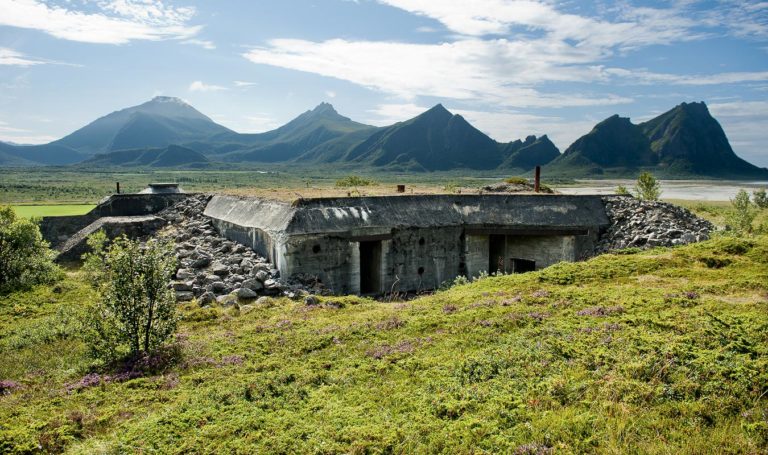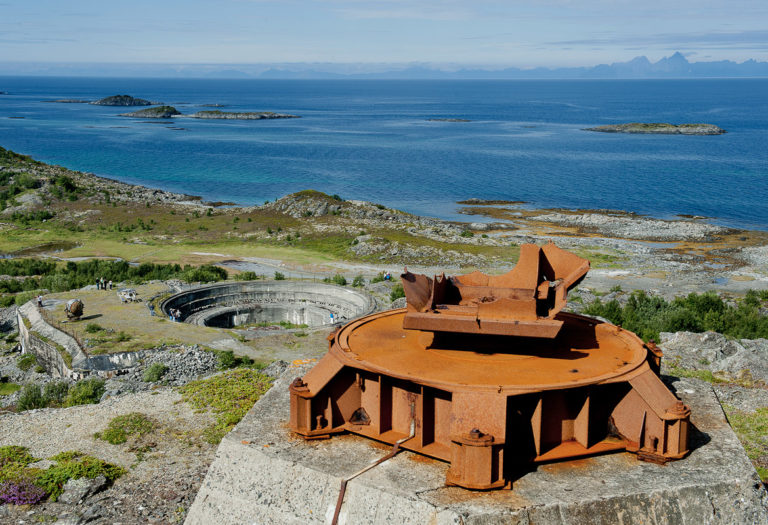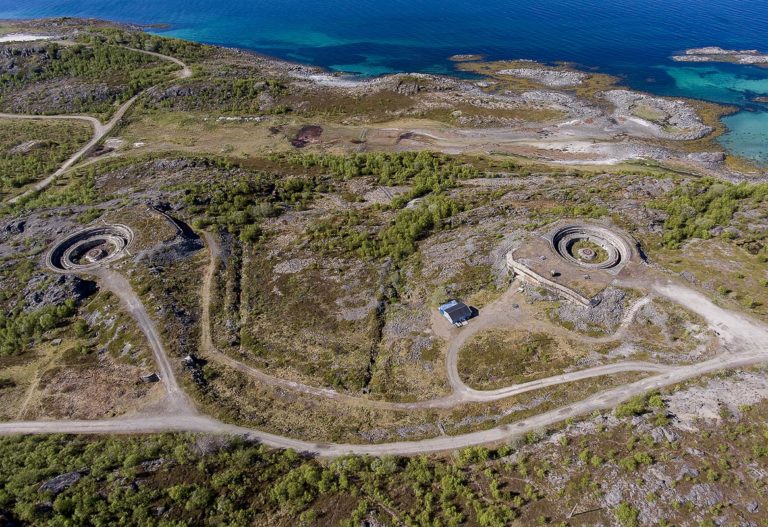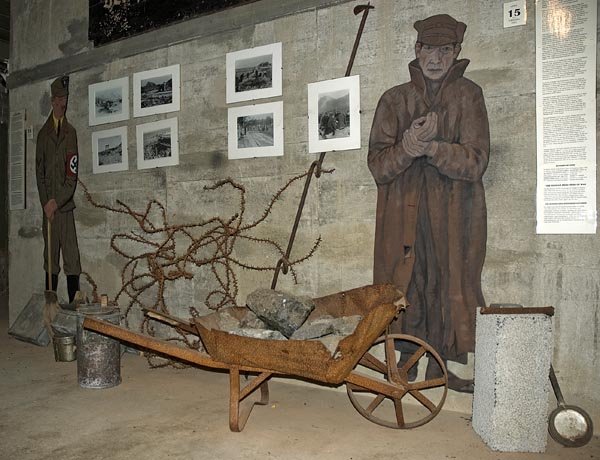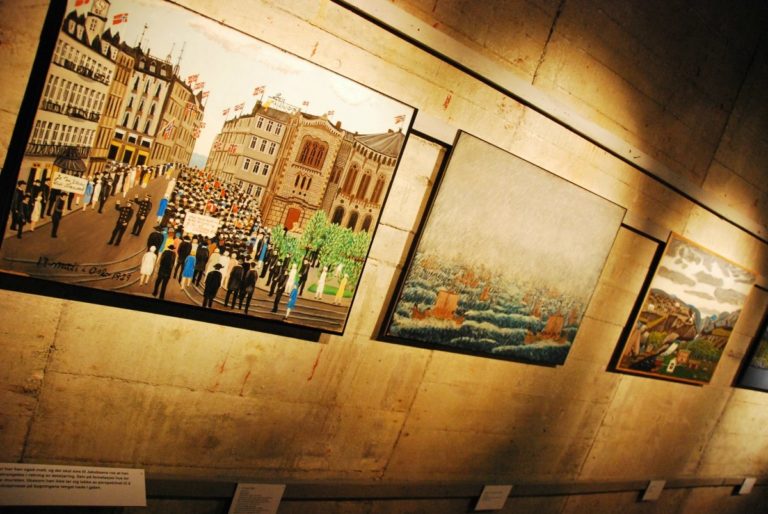When Norway was occupied by Nazi Germany during World War II, it was vital for the German war effort to be able to control the iron ore shipments from the Port of Narvik. Iron ore equals steel equals guns. The British attack on Narvik in April 1940 and the British raid on the Lofoten Islands in 1941 made the Germans determined to safeguard themselves against further British attacks in this vulnerable region.
Intended for battleships, the guns became an important coastal defence
At the Batterie Dietl coastal battery were installed some of the biggest land-based guns in the world, the so-called Adolf Guns. They were originally intended to be mounted on a new class of enormous German battleship, which was never built. Instead, the giant guns were used for coastal defences: on the coast of Poland, in France on the English Channel coast, and at Trondenes fortress in Northern Norway. Three of the guns were placed here at Batterie Dietl. All three were smelted down after the war, but in every other respect Batterie Dietl is a well-preserved coastal defence battery with an authentic bunker environment remaining almost as it was when the war ended.
Practical information on your visit to Batterie Dietl
Batterie Dietl is on Engeløya (island) in Steigen. After leaving the E6 at Tømmerneset it’s about 50km to Engeløyabrua (bridge to the island). Batterie Dietl is signposted well so just follow the road from Bø to the fortifications, approximately 3km. The closest stop for the ferry from Bodø is at Bogøy just south of Engeløyabrua.
Hourly tours are available during the Summer months mid June to Mid August from 11am to 6pm. However groups can book tours at other times of year upon appointment. For more information about the museum you can check the Nordlandsmuseet website which has information on Batterie Dietl and many other museums in the area.
For more information you check the webpage of Visit Bodo which has all the tips you’ll need to plan your trip.
The guns could shoot up to 56 kilometres
The Adolf Guns had a barrel diameter of 40.6 cm (16”), big enough to take an adult man. The shells, weighing up to 1 tonne (over 2,000 lbs) each, had a range of 56 kilometres (35 miles). Capable of firing up to one shell a minute, the guns enabled Batterie Dietl to control all of the Vestfjord (the southern approach to Narvik) so effectively that no Allied warship dared venture in. Batterie Dietl was part of the Atlantic Wall fortifications, the Third Reich’s coastal defence against the Allies.
The battery only took a year to be operational
Construction started on Batterie Dietl in the summer of 1942. By August 1943 two of the guns were operational, and in January 1944 the third and final gun was in place. However, building work continued at the battery right until the end of the war. Before the war, the island of Engeløya, where the battery is sited, was a remote community with neither electricity nor a road network, and so quays and roads to the coastal fort had to be built to enable the transport and handling of the heavy guns. The civilian population of Bø, the village close to the battery, was forcefully evacuated with only three days’ notice in the summer of 1943.
Prisoners were used as slave labour to build the battery
1700 prisoners of war from the Soviet Union and several hundred forced labourers from Norway and other European countries were set to work to build Batterie Dietl. The mortality rate among the Soviet Russians was extremely high, with more than 500 deaths, most during the first winter. Gradual improvements in the food and medical care did, however, radically reduce mortality levels. Some Norwegians also took paid employment at Batterie Dietl.
This was a naval battery, so soldiers slept in hammocks
Overgrown gravel tracks, crumbling concrete and rusty scrap iron; the area round the fort has not felt the tramp of soldiers’ boots for over 60 years. On a tour of Batterie Dietl we are taken into the concrete bunker beneath one of the three gun positions. The soldiers slept in hammocks, as this was a German naval battery. The hooks in the walls from which the hammocks hung are still there, with the German soldiers’ surnames written in Gothic lettering. Toilets and washbasins are also intact.
The guns may be gone but the evidence of their existence is plain to see
The guns themselves no longer exist, having been smelted down after the war. But the shells are still here, and you can also see the shell trolley, the traverse, a sort of rail that grasped the heavy one-tonne shell and guided it into the ammunition store. A door opens, and you go out to the base of the gun: a circular device with rails on which the shells were transported up to the gun. It is here that the enormous dimensions involved really strike you with full force.
Exhibitions are located in the bunker halls
Empty ammunition stores form great halls inside the bunker. In one of these a number of curiosities from the war are displayed, including porcelain from Porsgrund decorated with the Imperial German Eagle, as well as medals and other objects which the local people of Steigen took care of after the war. Nordlandsmuseet (Museum of Nordland) also has a thought-provoking exhibition in which Soviet POWs, German soldiers, German skilled workers posted to the battery, members of the local population, etc., tell their own stories. These people are fictional, but provide a telling glimpse of wartime lives. One ammunition hall houses art exhibitions, with a new show every summer.
The gun battery on Storøya island is also open but beware of the rising tide
The fortified area is large and accessible to all. There are a number of fine beaches, and it is possible to climb up the cliff to the radar station. The smaller gun battery on the island of Storøya is also open to the public and accessible, but be sure to keep an eye out for the tide; people have found themselves having to wade back from what is a real tourist trap. Also look out for holes in the ground hidden by vegetation, and for old bits of barbed wire. It is easy to be distracted by the stunning views across the sea to the mighty mountains of the Lofoten Islands known as “Lofotveggen”, the Lofoten Wall.
Batterie Dietl has guided tours in the Summer months
Like so many of the best things in Northern Norway, Batterie Dietl is in a remote spot, at the farthest point of Engeløya. Follow the signs from the main road through Steigen past Steigen Church, across cattle grids and past herds of cows until there is only a gravel track left. Then you will see the battery emerge. There are tours of the bunker every hour on the hour throughout the summer. It’s a good idea to take some warm clothing; summer warmth doesn’t penetrate far behind these thick concrete walls. Afterwards you can warm yourself with a cup of coffee in the hut outside, made using water from the water tank right at the bottom of the bunker!





